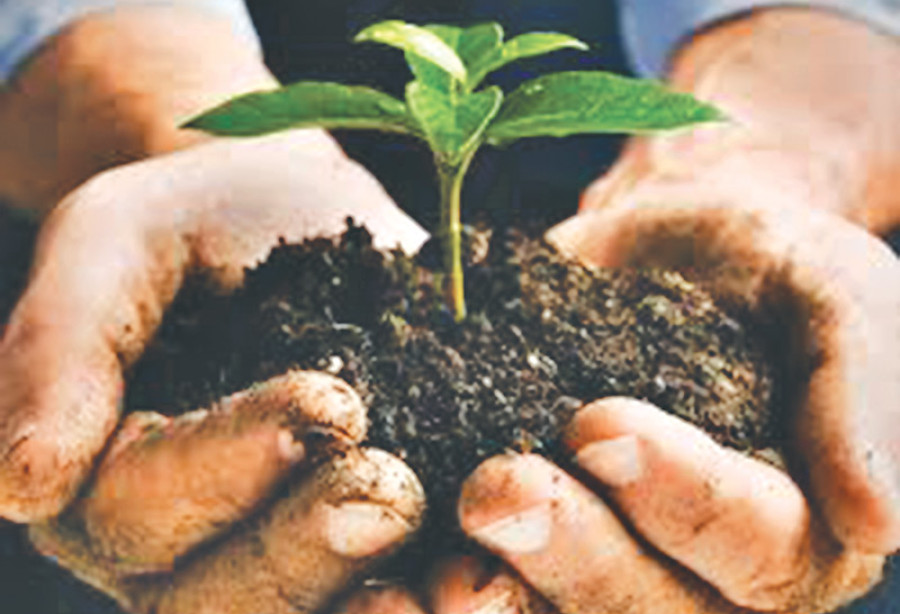Opinion
Down to earth
The soil must be revived through balanced use of chemical and organic fertilisers
Menila Kharel
Till not many decades ago, farming used to be done in a very humble way. Indigenous farming methods definitely cannot meet the kind of food demand we have today, but they kept the soil and plants in a healthy state. An organic lifestyle, which is quite a fancy term for today’s modern societies, was the normal lifestyle then. But as the number of mouths to feed increased and commercialisation intensified, neither the soil nor the crops remained chemical-free. A plant’s health is solely dependent on the quality of the soil as it provides food, fuel, fibre, medicines and more. Only healthy soil can provide a healthy life to plants and ultimately to animals too.
Healthy soil is also important for its ability to store water and make farming communities resilient to climate change. But unfair treatment and unwise use of soil has led to loss of organic matter leading to low soil fertility. Research has revealed that the organic matter content in the soil in Nepal is very low, approximately 1 percent when it should be 4-5 percent. The low organic-matter content is a threat to farm productivity in Nepal. Historically, soil fertility used to be maintained through an integrated farming system where organic matter and other nutrients in the soil were recycled by using farmyard manure. However, over the past three to four decades, cropping has dramatically intensified, and there has been indiscriminate use of chemical fertilisers.
Deteriorating health
Despite the increased use of chemical fertilisers, the rate of application per hectare of land is still low in Nepal. However, soil health continues to deteriorate because of increased use of such chemical fertilisers in a haphazard manner and the decreased use of organic fertiliser. This imbalance has been the primary reason behind the poor soil health in Nepal. This issue needs to be realised at the individual farming level and corrected urgently.
Nepal’s national plans and policies have prioritised fertilisers as an engine of agricultural growth. The government has introduced, lifted and then re-introduced subsidies on chemical fertilisers. Demand for chemical fertilisers has increased by an average of 15 percent every year over the last decade while supply remains short by 46 percent. However, supplying adequate quantities of chemical fertilisers to farmers across the country has always posed a challenge to the government. We need to explore alternatives to curb our dependency on imported chemical fertilisers without delay.
Policymakers are beginning to pay more attention to the problem of low organic matter in the soil and measures to address it. The 20-year vision of the Agriculture Development Strategy (ADS) 2015-35 has aimed to increase soil organic matter from 1 to 4 percent. Providing subsidies on the purchase of organic fertiliser, vermicompost production, cowshed improvement for separate collection of urine and dung, and the purchase of equipment to establish organic fertiliser factories, among others, are some of the plans to address the issue.
The number of private organic fertiliser producers is on the rise. Many of them have been receiving technical and financial support from the government. Even then, the use of organic inputs in Nepal is still woefully inadequate. “There has been a big difference in the quality of the soil compared to the past. The soil yielded more in the past while today it is compact and dry. That’s why I think it is not giving good yields,” said Machhe Narayan Ulak, of Panauti Municipality, Kavre.
Ulak is just a representative figure. His view reflects the woes of many farmers I met last year. They have seen the quality of the soil falling which has affected their production, yet they don’t know why that is happening. They apply chemical fertilisers and some farmyard manure, but it is clear that there is lack of awareness among farmers about the importance of soil health and organic matter content in it. Soil has life in it and hosts numerous other lives, and we have been taking away its life in bits and pieces. But if we start caring for it, there is still a chance that we can give it new life.
Maintaining fertility
It is possible to intensify agriculture to feed the growing population without disrupting the fertility of the soil. The science and practical solutions—sustainable agriculture practices—already exist. They include increasing the use of organic fertilisers which can be commercial or homemade (compost and vermicompost), re-introducing beneficial crop rotation (cereals, legumes and other crop types), improving the cycling of nutrients through the use of manure and designing crop-livestock farming systems. Growing green manure within or between crops with the purpose of returning organic matter and nutrients to the soil is also something that can be promoted. Our farmers and scientists need to work together to find practical, appropriate and economic ways to reduce our dependency on chemical fertilisers.
Let’s not confuse farmers by over-emphasising chemical fertilisers. Let’s encourage holistic action—judicious use of chemical fertilisers and sustainable agronomic practices, nutrient cycling, crop rotation, use of farmyard manure, compost and crop residues and other ways which were indigenously practiced but are vanishing with modernisation. Another area that could help enormously in strengthening the market value chain of organic fertiliser is recycling organic urban waste and processing and using faecal sludge as organic fertiliser. This could address both urban solid and liquid waste management issues and provide fertilisers to farmers. Research should be focused on making safe organic fertilisers from urban waste and faecal sludge by incentivising innovative public-private partnerships.
These actions require collaborative efforts from all actors—farmers, development organisations, the private sector and the government. We need to bring these actors together to add more organic matter to the soil and revive its fertility through a semi-organic production system, that is balanced use of chemical and organic fertilisers and sustainable agriculture practices. Together, let’s revive the soil and sustainably feed the generations to come!
Kharel is Programme Coordinator in the Agriculture and Food security Programme at Practical Action Regional Office




 16.24°C Kathmandu
16.24°C Kathmandu












